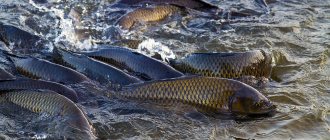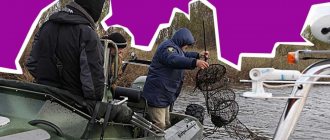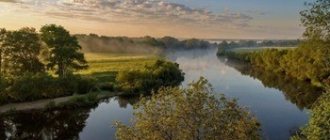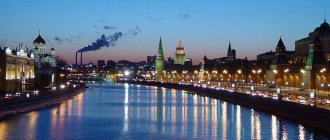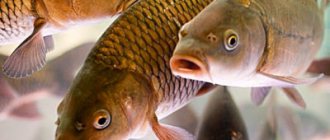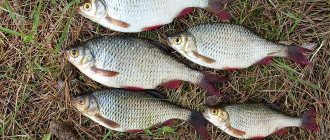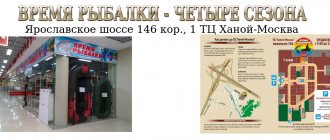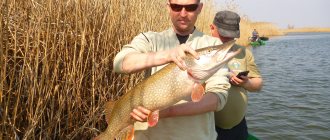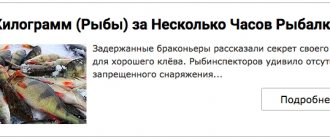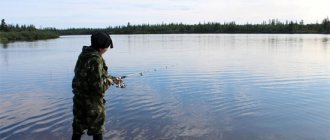Ministry of Agriculture of Russia
If you look at the document itself, its title reads as follows: Order of the Ministry of Agriculture of Russia dated November 18, 2014 N 453 (as amended on November 6, 2018) “On approval of fishing rules for the Volga-Caspian fishery basin (Registered with the Ministry of Justice of Russia on December 8, 2014 N 35097).
From it it becomes clear that the government body responsible for this law is the Russian Ministry of Agriculture. Actually, this is the source you need to turn to.
It also makes it clear that the fishing rules have existed for several years - this order was dated November 18, 2014, the latest changes were dated July 25, 2019 (there were no new editions in 2021 or 2021). In general, the rules appeared even earlier, so the law has long demanded that bream animals that have not passed the line control be released. But a serious increase in fines has only now spread the news about this law.
The official website is https://mcx.ru, to find the necessary information you need to go to the “documents” section, then “fishing” and enter the desired order in the search - “Order of the Ministry of Agriculture of Russia dated November 18, 2014 N 453.” You need to find the document - “Order of the Ministry of Agriculture of the Russian Federation dated November 18, 2014 N 453 On approval of fishing rules for the Volga-Caspian fishery basin (with amendments and additions).” This way you will be aware of all current editions.
Legislative acts
The fishing ban is established by the Federal Fisheries Agency. The State Duma adopted the Federal Law on November 26, 2004 “
This law has been agreed upon by all heads of the constituent entities of the Russian Federation. Each region determines its own procedure for imposing a ban by introducing certain rules, deadlines, and restrictions.
And here's what you need to know: Aiko spinning rods manufacturer - About fishing
The main documents defining the ban on fishing in each region are the Fishery Rules.
Legislation designed to protect fish populations from extinction is constantly being updated. The Russian Ministry of Agriculture periodically develops and forms new fishing rules. All existing restrictions clearly define fishing areas and the timing of the ban.
Excerpt from the rules for the Moscow region (relevant for 2021)
Minimum permissible size of extracted (caught) aquatic biological resources (commercial size)
(From clause 30.25.4.) When carrying out fishing, it is prohibited to produce (catch), accept, process, transship, transport, store and unload aquatic biological resources that have a fresh length (in cm) less than that specified in Table 27.
Table 27
| Name of aquatic biological resources | Fishing size , cm |
| Asp | 40 |
| Zander | 40 |
| Bream | 25 |
| Pike | 32 |
| Burbot | 40 |
| Carp | 40 |
| Chub | 20 |
| Ide | 25 |
From this table it follows that in the Moscow region it is allowed to catch roach of any size, according to the catch standards.
How is fish size determined?
(From clause 30.25.4.) The commercial size of aquatic biological resources is determined in fresh form: in fish - by measuring the length from the top of the snout (with the mouth closed) to the base of the middle rays of the caudal fin.
What to do if the fish is smaller
(From clause 30.25.4.) Extracted (caught) aquatic biological resources having a length less than that specified in Table 27 are subject to immediate release into the natural habitat with the least damage.
Prohibited species for catching
(From clause 30.25.3.) Species of aquatic biological resources prohibited for production (catch): sterlet, brown trout (trout) (freshwater residential form), freshwater catfish, grayling, podust, white-eye, bluefish, sabrefish, bersh, lampreys, crayfish .
Has anyone caught trout and, for example, saberfish in Moscow Region? -Rkarel is interested
Catch rate
(From clause 30.25.5.) The daily rate of production (catch) of aquatic biological resources (except for the case where such aquatic biological resources are subject to a permanent or temporary ban on production (catch) during recreational fishing) for each citizen during recreational fishing is indicated in table 27.1. Please note the fact (in bold), despite the mention in the table, catching crayfish in the Moscow region is prohibited by clause 30.25.3.
Table 27.1.
| Name of aquatic biological resources | Daily production (catch) rate |
| Zander | 3 copies |
| Pike | 5 copies |
| Cancers | 30 copies |
| Fry and live bait (bait) | 50 copies |
| Bloodworm | 0.2 kg |
The total daily production (catch) rate for all types of aquatic biological resources, including those not listed in Table 27.1, is no more than 5 kg or one specimen if its weight exceeds 5 kg.
If the total daily norm is exceeded, the extraction (catch) of aquatic biological resources is stopped.
Two or more daily norms
The law limits the daily catch rate, mentions a two-day rate, etc. - No. It is very ambiguous, if you stay on a reservoir for more than a day, there are no permits for fishing with double, etc. standards, or a direct ban.
According to an oral explanation from a specialist from the RosRybolovstvo hotline: the norm is no more than 5 kg, otherwise there will be a fine, because it is not possible to prove the number of days spent on the ice.
But there is also a written explanation from the North-Western Territorial Administration of RosRybolovstvo (see below).
Prohibited periods (spawning ban), and whether it is possible to fish with a spinning rod and feeder (donks) during the ban
(From clause 30.25.2.) Prohibited periods (periods) of extraction (catch) of aquatic biological resources:
- from March 22 to June 1 - in the cooling ponds of the Shaturskaya and Elektrogorskaya State District Power Plants;
- on other water bodies of fishery importance: from April 1 to June 10 - with all fishing gear, with the exception of one float or bottom fishing rod from the shore with a total number of hooks of no more than 2 pieces per citizen outside the spawning areas specified in Appendix No. 6 to the Fishing Rules “List of spawning areas...” (see the rules);
- from October 1 to April 30 - in wintering pits specified in Appendix No. 5 to the Fishery Rules “List of wintering pits located on water bodies of fishery significance in the Volga-Caspian fishery basin”;
- from December 15 to January 15 – burbot.
From this point it follows that fishing with a spinning rod in the Moscow region is prohibited, but with a feeder (donka) it is possible.
☸️ What fishing is considered illegal in the Russian Federation, and where you can’t fish?
You can learn more about prohibited fishing from the relevant laws. For example, from Federal Law No. 166 (note “On fishing ...”). According to this law, you can fish freely and freely if you do it on water bodies for which no special use regime has been established. But even under these conditions, you may be subject to restrictions approved by law.
The main list of restrictions is regulated by the federal body - Rosrybolovstvo.
☸️ These include...
- Fishing bans in certain areas and prohibitions on catching certain types of fish.
- A certain weight and size of the fish caught.
- Number, type, size and design of fishing devices and fishing methods.
- Permitted/prohibited periods for fishing.
- Sizes, number and types of fishing vessels.
- Catch volume per 1 private person or 1 vessel.
...And other restrictions.
As for the specific permitted places for fishing in Russia, they are determined by each region independently.
☸️ The places that are prohibited everywhere are the following...
- Near bridges, locks, near dams and hydraulic structures, near fish/factories and cages for raising young animals.
- On water bodies of spawning farms.
- On the fairway from a boat.
- In nature reserves.
- In fish hatcheries.
- In pond/fish farms.
- In spawning grounds during spawning.
- At fish hatchery facilities during the release of young fish.
☸️ Prohibited fishing gear - what can’t you fish with?
- Networks of any type/type.
- Traps of any design/type (with the exception of crayfish traps).
- Passive fishing gear (approx. - hooks, pokes, etc.) on those rivers that are known for their habitats of salmon species.
- Pneumatic weapons (except for devices intended for underwater hunting).
- Fishing rods/spinning rods of any type, system, design with a total number of hooks - over 10 pieces per person.
- Trawls, bottom seines.
- Hook trap devices.
- Network devices/devices (seines and televisions, drills and capes, scarves, etc.).
- Lifters/scoops with dimensions over 1x1 m and mesh pitch over 10 mm.
- Traps and catfish traps.
- Spears and other piercing tools for fishing.
☸️ Prohibited methods of fishing - how can you not fish?
- For undercutting and lighting.
- Stunning fish.
- Trolling using a sail and motor with more than 2 baits.
- By means of barriers that become an obstacle to the free movement of fish (dams, etc.).
- Using circles/langes with the number of hooks - over 10 pcs per person.
- Using crayfish traps when their quantity is more than 3 pieces per person, with a mesh size of less than 22 mm and a device diameter of more than 80 cm.
- By sewing with a total number of hooks - over 10 pieces per person.
- Using the diving method or manually wading when catching crayfish.
- On the close.
- Combines and oilseed traps.
- Descent of reservoirs.
- With the installation of huts on ice.
- From ships and other watercraft that have not been properly registered and do not have legal identification marks on board.
- Electric shock and firearms.
- Electric fishing rods.
- Using watercraft during spawning.
- Scuba diving, underwater.
☸️ Prohibited fishing periods - when is it forbidden to fish?
As for the timing of the fishing ban, they are set by regions individually and change every year, depending on the situation. For example, pike spawning is the end of winter, the beginning of spring +/- 2 weeks. And perch spawning begins after the water warms up to +7.
DATES BY REGION, see the section FISHING RULES.
Be careful! Fishing during spawning is strictly prohibited!
On December 12, 2021, the Duma adopted a new law on recreational fishing (read the full text), which comes into force in 2020.
☸️ Ban on fishing according to its length - acceptable values
It is worth noting that the length of the fish is measured from the highest point of the snout (approx. with the mouth closed) to the base of the middle rays of the caudal fin. For crustaceans, this value will be equal to the length of the body from the end of the tail plates to the line that connects the middle of the eyes.
If the length of the caught fish is less than acceptable, it must be released “home” with a minimum of damage.
So, the valid values are:
- For carp – 30 cm.
- For crayfish - 9 cm.
- For pike perch – 38 cm.
- For burbot – 40 cm.
- For pike – 32 cm.
- For asp – 35 cm.
- For catfish – 40 cm.
- For chub – 20 cm.
- For carp – 24 cm.
- For vimbe - 22 cm.
- For ramming - 16 cm.
- For grass carp – 45 cm.
- For bream – 17-28 cm (depending on the region).
- For trout – 15 cm.
- For subust – 15 cm.
- For bersh – 25 cm.
- For barbel – 20 cm.
- For herring – 15 cm.
- For silver carp – 50 cm.
- Perch - 15 cm.
- Roach - 18 cm.
☸️ Ban on fishing according to its quantity - acceptable values
In terms of the amount of catch, the law determines the following:
- The catch rate per person/day is 5 kg of fish. In this case, there is only one exception - in the case when the weight of the first fish is higher than the catch norm.
- The norm for exporting fish is no more than double the norm for 2 days of stay (export in any form - salted or dried, smoked and raw).
- There are no restrictions on the catch of bleak, minnows and ruffs.
- The catch rate for crayfish is no more than 30 pieces per person/day.
- is strictly prohibited without a license.
- Bait fishing - no more than 30 live bait per person/day.
☸️ Prohibited fish breeds - which ones should you not catch?
Lists of prohibited fish are determined individually in each region.
- For example, for Moscow and the Moscow region - trout and sterlet, crayfish with lampreys, bersh and catfish, podust and sabrefish, white-eye, grayling.
- And in the Kama region it is prohibited to catch trout, taimen, Russian sturgeon and sterlet.
- For the entire territory of the Russian Federation there are restrictions on the size of pike and burbot, bream, and pike perch caught.
- There is a strict ban on fishing for pike, pike perch, asp and bream - if they are used as bait.
- There is a categorical ban on catching the following fish: Atlantic sturgeon (listed in the Red Book, the fine for fishing is about 40,000 rubles), large pseudoshovel, Aral salmon (rare species, 1st category of protection), etc.
Scars
Fines are prescribed in Article 8.37 of the Code of Administrative Offenses of the Russian Federation, Part 2 and in Decree of the Government of the Russian Federation dated November 3, 2018 N 1321 “On the approval of fees for calculating the amount of damage caused to aquatic biological resources.”
Piece fines, with current fish for the Moscow region, are provided in the table; you can view the full document at the link - https://publication.pravo.gov.ru.
Table of penalties for (1 copy regardless of size and weight)
| Aquatic biological resources | Tax (rub.) |
| Sterlet | 4572 |
| Zander | 3305 |
| Asp, carp, pike | 925 |
| Burbot, bersh, tench, ide, bream, silver bream | 500 |
| Chub | 250 |
When calculating damage during periods prohibited for fishing and (or) in areas prohibited for fishing, in addition to the taxes, 100% of the tax per specimen (kilogram) of the corresponding species (subspecies) is taken into account.
Fines under the Code of Administrative Offenses
General fines for violations of fishing rules are prescribed in Article 8.37 of the Code of Administrative Offenses of the Russian Federation, Part 2, the full document can be found at the link - https://pravo.gov.ru.
(Article 8.37, Part 2) Violation of the rules regulating fishing, except for the cases provided for in Part 2 of Article 8.17 of this Code (as amended by Federal Law No. 120-FZ of May 2, 2015), entails the imposition of an administrative fine on citizens in the amount of two thousand to five thousand rubles with or without confiscation of the vessel and other equipment for the extraction (catch) of aquatic biological resources ; for officials - from twenty thousand to thirty thousand rubles with or without confiscation of the vessel and other equipment for the extraction (catch) of aquatic biological resources; for legal entities - from one hundred thousand to two hundred thousand rubles with or without confiscation of the vessel and other equipment for the extraction (catch) of aquatic biological resources (as amended by Federal Law No. 91-FZ of May 7, 2013).
Water bodies of fishery importance in the Leningrad region and St. Petersburg
Fishing is prohibited:
- from October 1 to November 30 in the Neva River from the mouth upstream to the village. Fishing using spinning rod ;
- from October 1 to November 15 in the Neva River from the confluence of the Mga River to the village. Maryino using a spinning rod ;
- from October 1 to November 30 in the Luga River from the village. Lesobirzha upstream to the intersection with the railway line in the area of the village. Tolmachevo (within populated areas 1.5 km down and up the river) using a spinning rod ;
- from October 1 to November 30 in the Svir River from the mouth to the 500-meter restricted zone of the Nizhne-Svirskaya Hydroelectric Power Station using spinning rods .
Types of aquatic biological resources prohibited for extraction (catch):
- Atlantic sturgeon, lake trout, brown trout (freshwater residential form), Atlantic salmon (salmon) (except for salmon in the Narva River in fishing grounds provided for the organization of recreational and sport fishing).
Current issues
How many zherlitsy or circles are allowed to be used?
According to paragraph 29 of the fishing rules for the Volga-Caspian fishery basin, it is allowed to fish with circles and girders with a total number of hooks of no more than 10 pieces on the fishing gear of one citizen.
A double or a tee is one hook or several
Double and tee are one hook.
Is trolling allowed?
According to paragraph 29 of the fishing rules for the Volga-Caspian fishery basin, trolling using a sail and/or motor is permitted using no more than two baits per vessel or floating craft.
Bream, white bream and silver bream are different fish or one
A bream is a young specimen of bream, and therefore falls under the minimum fish size requirements. White bream is a separate species; it is allowed to catch any size, according to the catch standards.
How to distinguish bream from silver bream
The main differences are in the size of the scales - in the silver bream it is larger; It’s even easier to determine by the eye - the eye of the silver bream is larger, on average, from the eye to the nose of the silver bream - the same diameter; Bream have two eye diameters. You can say that bream has a “longer nose.”
Is echo sounder allowed?
According to the Federal Law of December 25, 2018 No. 475-FZ On Recreational Fishing and on Amendments to Certain Legislative Acts of the Russian Federation (Article 7, Part 4), the ban on the use of individual electronic means of detecting aquatic biological resources under water (echo sounder) refers to the implementation of amateur fishing by the method of underwater extraction of aquatic biological resources (spearfishing).
Spawning ban on spinning rods and when does it apply?
Many novice fishing enthusiasts are wondering: is there a ban on spinning fishing? Regarding the time of day, there are no barriers: you can fish in the morning, evening and even late at night. The fisherman has the right to choose the optimal time for his hobby and no one will interfere with him. Temporary prohibitions primarily relate to the time of year, and this is spring.
In the spring, the fish go out to spawn, during which industrial fishing is suspended, but spinning is quite legal. In addition to this, during this period it is allowed to fish with such gear as fishing rods with a float, mugs and girders. However, they should not be homemade, because homemade is equivalent to poaching. According to the rules of legal fishing, gear should not have more than ten hooks.
From the above it follows that the spawning ban does not apply to spinning rods. Regulatory authorities do not have the right to issue you a fine, however, there are some pitfalls here:
- It is prohibited to go fishing by boat.
- It is prohibited to fish in places where they spawn.
- You can fish exclusively with one fishing rod and one hook.
- You can fish in any place that is not a spawning area.
Before you go to a body of water, make sure that it is not one of the prohibited places for fishing and, in particular, places where there is a ban on spinning fishing. Such places exist in Russia, but, fortunately, they are few.
Republic of Karelia
Fishing is prohibited:
- from October 1 to October 31 in lakes Pongoma and Vokshozero (the Pongoma river basin);
- from October 1 to December 1 on Lake Vingelozero and the Niva River, including
500-meter zone of source and mouth;
- from September 20 to October 30 in Lake Tikshozero fishing (catch) with nets in the following areas: in the northwestern part of the lake within the boundaries of the line: Cape Khlebnavolok - Kaigas Island - Cape Dedova Bay; in Dedova Bay (Unalaksha) and Vinchevskaya within the boundaries to the line: Cape Dedova Bay - Cape Varalaksha (with the exception of Stepanova and Varalaksha Bays); in Syargilaksha Bay within the boundaries to the line: the mouth cape of the Shatta-joki River - Cape Syarginiemi; in Khlebnaya Bay within the boundaries to the line: Cape Khlebnavolok - Cape Taibolgubsky;
- from September 1 to November 15 in the rivers Lenderka, Emelyanovka, Luzinka, Sula, except for fishing (catch) with hand-held hook fishing (catch) tools with a total number of single hooks of no more than 4 on the citizen’s fishing (catch) gear and the length of the line ( cord) no more than 10 meters;
- from October 15 to December 31 in the Tula (Luzhma) River, in Lake Thulos, within a radius of less than
1 km before the source of the Tula (Luzhma) River, except for fishing (catching) with hand-hooked fishing (catch) tools with a total number of single hooks of no more than 4 on the citizen’s fishing (catch) gear and line (cord) length no more than 10 meters ;
- from October 5 to October 30 in Lake Syamozero in a kilometer-long coastal zone around the islands of Koivusuari, Vezisuari and Kudomsuari.
Lake Onega and the basins of rivers flowing into it
- from August 15 to November 15 in the rivers Orzega, Derevyanka, Neloksa, Pukhta, Gimreka, Rybreka, Shoksha, Uya, Other, Iron Brook, Vantik, Mirozlavl, Petruchey, Yaniruchey, Vekhruchey, Sheltozerka, Kaskesruchey, as well as in front of the mouths of these rivers on a distance of less than 1 km in both directions from the mouths and deep into Lake Onega;
- from September 15 to November 30 in Chelmuzhskaya Bay, as well as deep into the lake from its neck to the line: the northern tip of the island of Hare-Cape - Cherny Navolok;
- from September 10 to October 20 in Bolshaya Lizhemskaya Bay;
- from September 10 to November 30 on the coastal area within the boundaries from Cape Rachnavolok to Cape Sukhoi Nos along the line of the Zayachii - Lebyazhyi - Peter islands and deep into the lake at a distance of less than 1 km from this line;
- from September 10 to October 20 on the banks of Jerusalem, Uritsky, Monastyrskaya, Sukhaya Luda, including a two-kilometer zone around them, and at a distance
2 km around the islands of Paleoostrov, Kobyliy, Rechnoy, Dubostrov, Plovets;
- from October 15 to November 15 in Nyatino Bay (within the borders to the line: Cape Klimetsky Nos - Cape Shirokiy Navolok), Konda (within the borders to the line: Cape Shiroky Navolok - Cape Vostochny Ridnavolok), Voyguba (within the borders to the line: from Cape Lavnavolok in a northern direction to Cape Voinavolok);
- from September 10 to October 20 in the kilometer-long coastal zone from Cape Oravnavolok to Cape Rachnavolok, from Cape Usov Navolok to Cape Klim-Nos (with the exception of Keften and Svyatukha lips) and at a distance of less than 1 km around the islands of Selgostrov, Kainos and Luda Lag.
Prohibited production (catch):
- from September 10 to October 10 in Lake Maslozero, harvesting (catch) of pallia using nets with a mesh size (pitch) of less than 40 mm;
- from October 1 to November 30 in Lake Segozero, fishing (catch) of whitefish (freshwater residential form) with nets with a mesh size (pitch) of 36 mm - in the bays of Sondalskaya, Orchun, Turikka, Shunsu, Kuyva, Siga, Meri, Lakka, Seppya, Kechan , as well as in a kilometer zone around the Kalichy Islands;
- from October 15 to November 30 in Lake Seletskoye, vendace is harvested (caught) using nets with a mesh size (pitch) of 16 - 22 mm;
- from October 20 to December 20 in Lake Ladmozero, vendace is harvested (caught) using nets with a mesh size of 16–22 mm.
Water bodies of fishery importance or parts thereof located on the territory of the Arkhangelsk region
Amateur and sport fishing is prohibited:
- in wintering pits on the Northern Dvina and Vychegda rivers in accordance with Appendix No. 4 to the Fishing Rules “List of wintering pits on the territory of the Arkhangelsk region” in the period from October 1 until the ice melts.
Water bodies of fishery significance or parts thereof located on the territory of the Komi Republic
Amateur and sport fishing is prohibited:
- in water bodies of fishery significance in the territories of the municipalities of the urban districts "Vorkuta" and "Inta", with the exception of the Silovaya-Yakha River from September 15 to November 15, with the exception of fishing (catching) with hand-held fishing gear (catch) with a total number of single hooks not more than 4 on a citizen’s fishing gear and the length of the line (cord) is no more than 10 meters;
- in wintering pits on the Vychegda River in accordance with Appendix No. 5 to the Fishing Rules “List of wintering pits on the Vychegda River on the territory of the Komi Republic” in the period from October 1 until the ice melts;
- in wintering pits on the Pechora River in accordance with Appendix No. 6 to the Fishing Rules “List of wintering pits on the Pechora River on the territory of the Komi Republic” in the period from October 1 until the ice melts.
